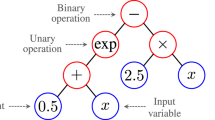Abstract
The objective of this study was to develop an optimum artificial neural network (ANN) capable of predicting the direction and magnitude of the moisture flux through wood under nonisothermal steady-state diffusion. A comparison between experimental measurements and the predicted values of three mathematical models reported in the literature and of the proposed neural network is presented and discussed. When developing the ANN model, several configurations were evaluated. The optimal ANN model was found to be a network with six neurons in one hidden layer. This well-trained network correlated the forecasted to the experimental data with low-level errors compared to previously developed models and also predicted the flux-reversal phenomenon thus confirming that ANN modeling has a much better predictive performance. It was also shown that the numbers of the training data were linked to the performance of the network during estimation. However, the powerful predictive capacity of this modeling method was still supported although a limited experimental data set was trained.
Zusammenfassung
Ziel dieser Arbeit war die Entwicklung eines optimalen neuronalen Netzwerks (ANN) zur Bestimmung der Richtung und der Grössenordnung der Feuchtebewegung in Holz bei nicht isothermischer stationärer Diffusion. In der vorliegenden Arbeit werden die empirischen Werte mit den Ergebnissen von drei der Literatur entnommenen Rechenmodellen sowie mit dem entwickelten neuronalen Netzwerk verglichen und diskutiert. Bei der Entwicklung des ANN-Modells wurden verschiedene Konfigurationen untersucht. Dabei hat sich ein Netzwerk mit einer inneren Schicht mit sechs Neuronen als optimal erwiesen. Verglichen mit bisher entwickelten Modellen führte dieses gut trainierte Netzwerk zu einer besseren Übereinstimmung mit den Versuchsdaten. Es erklärte auch die “Umkehrdiffusion”. Damit wurde die bessere Vorhersagegenauigkeit der ANN-Modellierung bestätigt. Darüber hinaus konnte gezeigt werden, wie die Anzahl der Trainingsdaten das Ergebnis der Netzwerkmodellierung beeinflusst. Trotz der begrenzten Anzahl der für das Trainieren verwendeten Versuchsdaten wurde die sehr gute Vorhersageleistung dieser Methode bestätigt.
Similar content being viewed by others
References
Avramidis S (1986) Nonisothermal diffusion of moisture in wood and sorption studies. Ph.D. Thesis. SUNY – College of Environmental Science and Forestry, Syracuse, NY
Avramidis S, Hatzikiriakos SG (1995) Convective heat and mass transfer in nonisothermal moisture desorption. Holzforschung 49:163–167
Avramidis S, Hatzikiriakos SG, Siau JF (1994) An irreversible thermodynamics model for unsteady-state nonisothermal moisture diffusion in wood. Wood Sci Technol 28:349–358
Avramidis S, Iliadis L (2005) Wood-water sorption isotherm prediction with artificial neural networks: A preliminary study. Holzforschung 59:336–341
Avramidis S, Kuroda N, Siau JF (1987) Experiments in nonisothermal diffusion of moisture in wood. Part II. Wood Fiber Sci 19(4):407–413
Avramidis S, Siau JF (1987) An investigation of the external and internal resistance to moisture diffusion in wood. Wood Sci Technol 21:249–256
Bishop MC (1994) Neural network and their applications. Rev Sci Instrum 64(6):1803–1831
Genel K, Ozbek I, Kurt A, Bindal C (2002) Boriding response of AISI W1 steel and use of artificial neural network for prediction of borided layer properties. Surf Coat Technol 160(1):38–43
Chen CR, Ramaswamy HS, Alli I (2001) Prediction of quality changes during osmo-convective drying of blueberries using neural network models for process optimization. Dry Technol 19(3/4):507–523
Hornik K, Stinchombe M, White H (1989) Multilayer feedforward network are universal approximator. Neural Network 2:359–366
Islam MR, Sablani SS, Mujumdar AS (2003) An artificial neural network model for prediction of drying rates. Dry Technol 21(9):1867–1884
Islamoglu Y, Kurt A (2004) Heat transfer analysis using ANNs with experimental data for air flowing in corrugated channels. Int J Heat Mass Transf 47:1361–1365
Lin TY, Tseng C (2000) Optimum design for artificial neural networks: an example in a bicycle derailleur system. Eng Appl Art Int 13:3–14
Liu TQ, Sun XY, Li XQ, Wang HL (2002) Neural network analysis of boiling heat transfer enhancement using additives. Int J Heat Mass Transf 45:5083–5089
Myhara RM, Sablani S (2001) Unification of fruit water sorption isotherms using artificial neural networks. Dry Technol 19(8):1543–1554
Ni H, Gunasekaran S (1998) Food quality prediction with neural networks. Food Technol 52(10):60–65
Sablani SS, Baik OD, Marcotte M (2002) Neural networks for predicting thermal conductivity of bakery products. J Food Eng 52:299–304
Sablani SS, Kacimov A, Perret J, Mujumdar AS, Campo A (2005) Non-iterative estimation of heat transfer coefficients using artificial neural network models. Int J Heat Mass Transf 48:665–679
Scalabrin G, Piazza L (2003) Analysis of forced convection heat transfer to supercritical carbon dioxide inside tubes using neural networks. Int J Heat Mass Transf 46:1139–1154
Scalabrin G, Piazza L, Condosta M (2003) Convective cooling of supercritical carbon dioxide inside tubes: heat transfer analysis through neural networks. Int J Heat Mass Transf 46:4413–4425
Siau JF (1983a) A proposed theory for nonisothermal unsteady-state transport of moisture in wood. Wood Sci Technol 17:75–77
Siau JF (1983b) Chemical potential as a driving force for nonisothermal moisture movement in wood. Wood Sci Technol 17:101–105
Siau JF (1984) Chemical potential and nonisothermal diffusion. Letter to the editor. Wood Fiber Sci 16(4):628–629
Siau JF (1992) Nonisothermal diffusion model based on irreversible thermodynamics. Wood Sci Technol 26(5):325–328
Siau JF, Avramidis S (1993) Application of a thermodynamic model to nonisothermal diffusion experiments. Wood Sci Technol 27(2):131–136
Siau JF, Bao F, Avramidis S (1986) Experiments in nonisothermal diffusion of moisture in wood. Wood Fiber Sci 18(1):84–89
Su G, Fujuda K, Morita K, Pidduck M (2002) Application of artificial neural network for the prediction of flow boiling curves. J Nucl Sci Technol 39(1):1190–1198
Xie G, Xiong R (1999) Use of hyperbolic and neural network models in modeling quality changes of dry peas in longtime cooking. J Food Eng 41(3–4):151–162
Zeng P (1998) Neural computing in mechanics. Appl Mech Rev 51(2):173–197
Author information
Authors and Affiliations
Corresponding author
Rights and permissions
About this article
Cite this article
Avramidis, S., Wu, H. Artificial neural network and mathematical modeling comparative analysis of nonisothermal diffusion of moisture in wood. Holz Roh Werkst 65, 89–93 (2007). https://doi.org/10.1007/s00107-006-0113-0
Published:
Issue Date:
DOI: https://doi.org/10.1007/s00107-006-0113-0




